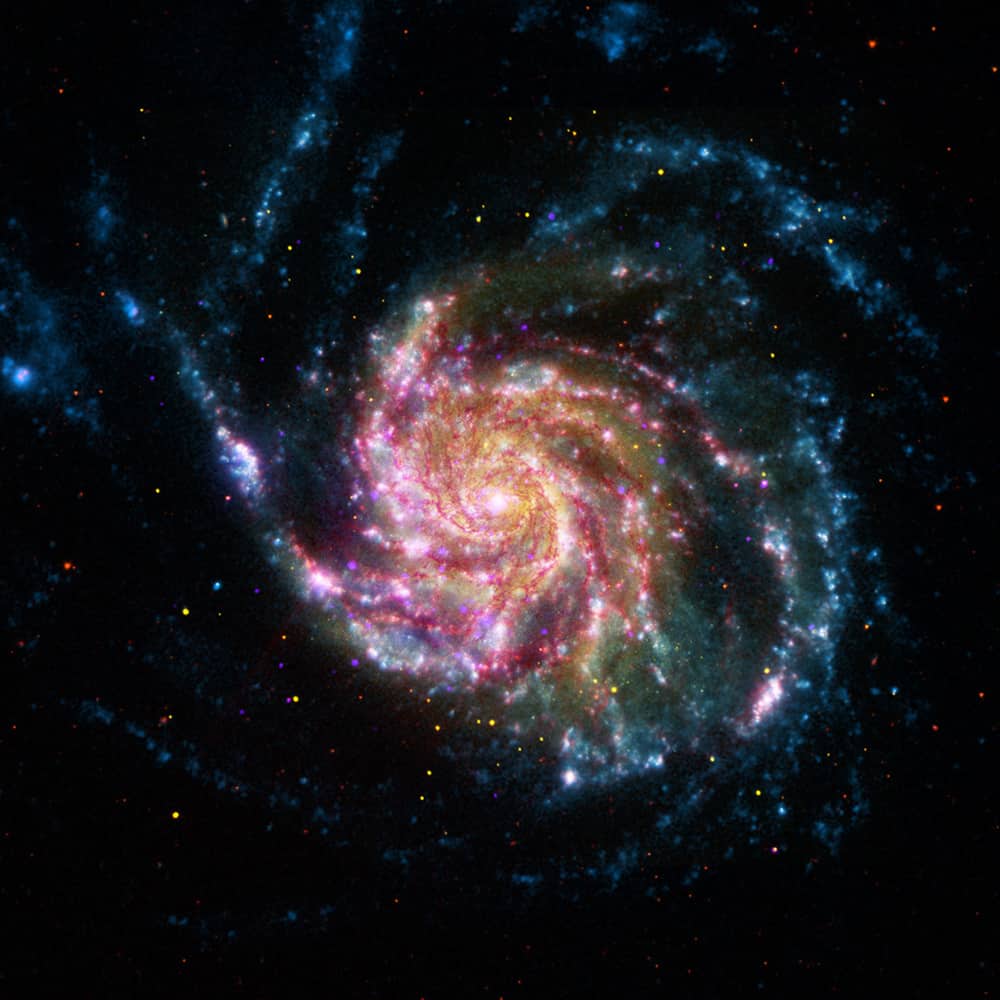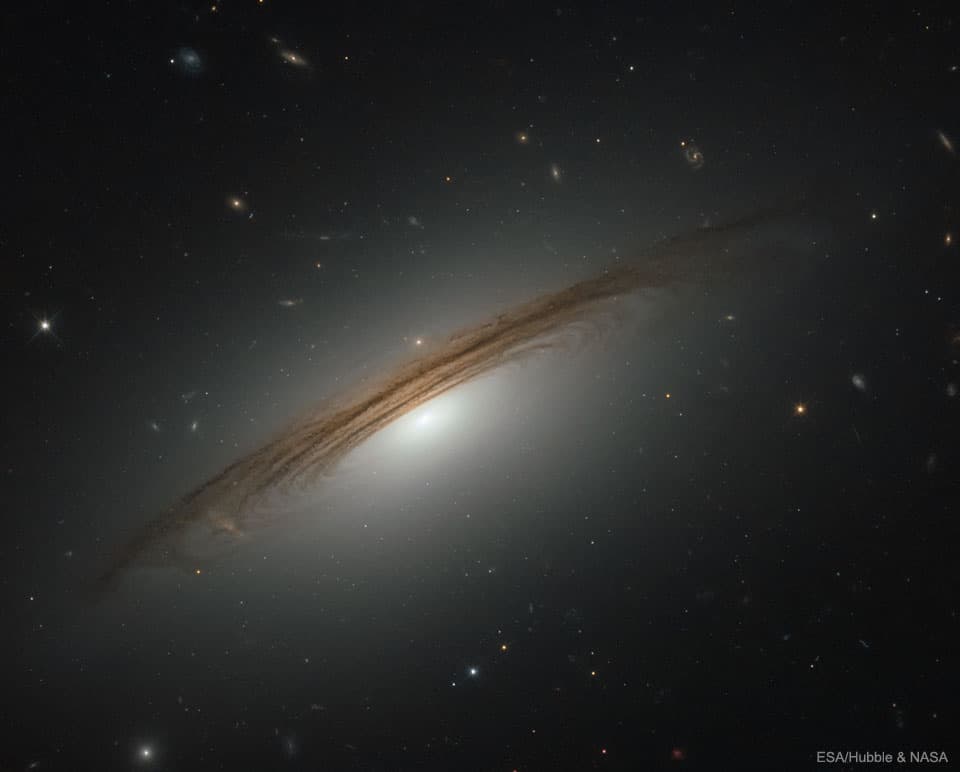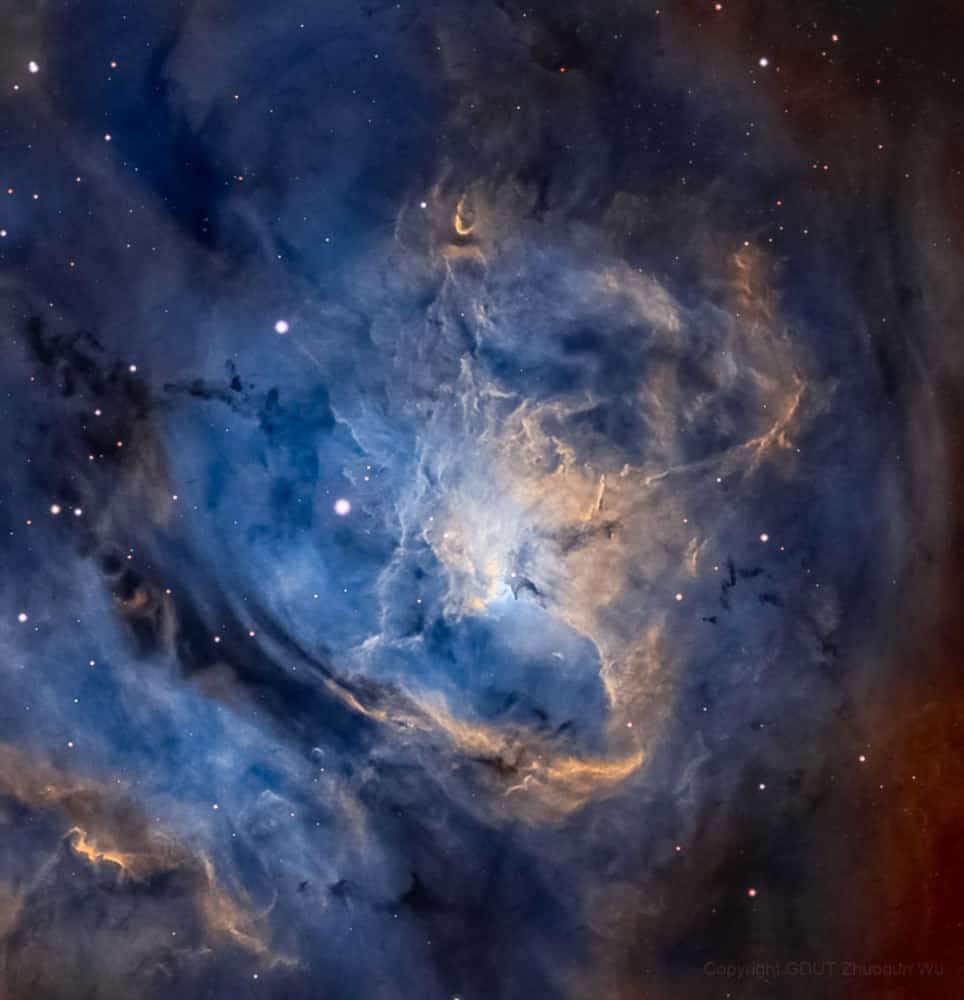Blog
Wilder Community Center for Aging in St Paul. Wednesday November 6th Great Room session 945-1145am & Day Room session 1-230pm. Also November 11th & 13th.

more...
This image of the Pinwheel Galaxy, or M101, combines data in the infrared, visible, ultraviolet and x-rays from four of NASA’s space telescopes. This multi-spectral view shows that both young and old stars are evenly distributed along M101’s tightly-wound spiral arms. Such composite images allow astronomers to see how features in one part of the spectrum match up with those seen in other parts. It is like seeing with a regular camera, an ultraviolet camera, night-vision goggles and X-Ray vision, all at once! The Pinwheel Galaxy is in the constellation of Ursa Major (also known as the Big Dipper). It is about 70% larger than our own Milky Way Galaxy, with a diameter of about 170,000 light years, and sits at a distance of 21 million light years from Earth. This means that the light we’re seeing in this image left the Pinwheel Galaxy about 21 million years ago – many millions of years before humans ever walked the Earth. The red colors in the image show infrared light, as seen by the Spitzer Space Telescope. These areas show the heat emitted by dusty lanes in the galaxy, where stars are forming. The yellow component is visible light, observed by the Hubble Space Telescope. Most of this light comes from stars, and they trace the same spiral structure as the dust lanes seen in the infrared. The blue areas are ultraviolet light, given out by hot, young stars that formed about 1 million years ago. The Galaxy Evolution Explorer (GALEX) captured this component of the image. Finally, the hottest areas are shown in purple, where the Chandra X-ray observatory observed the X-ray emission from exploded stars, million-degree gas, and material colliding around black holes.

Glenn Lewis Frey (/fraɪ/; November 6, 1948 – January 18, 2016) was an American singer, songwriter, actor and founding member of the rock band the Eagles. Frey was the co-lead singer and frontman for the Eagles, roles he came to share with fellow member Don Henley, with whom he wrote most of the Eagles’ material. Frey played guitar and keyboards as well as singing lead vocals on songs such as “Take It Easy“, “Peaceful Easy Feeling“, “Tequila Sunrise“, “Already Gone“, “James Dean“, “Lyin’ Eyes“, “New Kid in Town“, and “Heartache Tonight“.
After the breakup of the Eagles in 1980, Frey embarked on a successful solo career. He released his debut album, No Fun Aloud, in 1982 and went on to record Top 40 hits “The One You Love“, “Smuggler’s Blues“, “Sexy Girl“, “The Heat Is On“, “You Belong to the City“, “True Love“, “Soul Searchin’” and “Livin’ Right“. As a member of the Eagles, Frey won six Grammy Awards, and five American Music Awards. The Eagles were inducted into the Rock and Roll Hall of Fame in 1998, the first year they were nominated. Consolidating his solo recordings and those with the Eagles, Frey had 24 Top 40 singles on the Billboard Hot 100.
Frey was born in Detroit, Michigan. Growing up in Royal Oak, Michigan, he studied piano at age five, later switched to guitar, and became part of the mid-1960s Detroit rock scene. One of his earliest bands was called the Subterraneans, named after Jack Kerouac‘s novel, and included fellow Dondero High School classmates Doug Edwards (later replaced by Lenny Mintz) on drums, Doug Gunsch and Bill Barnes on guitar and Jeff Hodge on bass.
https://www.youtube.com/watch?v=ceO_QpHeLAQ
more...Arturo Sandoval (born November 6, 1949) is a Cuban-American jazz trumpeter, pianist and composer.
Sandoval, while living in his native Cuba, was influenced by jazz musicians Charlie Parker, Clifford Brown, and Dizzy Gillespie, finally meeting Gillespie later in 1977. Gillespie became a mentor and colleague, playing with Sandoval in concerts in Europe and Cuba and later featuring him in the United Nations Orchestra. Sandoval defected while touring with Gillespie in 1990, and he became an American naturalized citizen in 1998.
His life was the subject of the film For Love or Country: The Arturo Sandoval Story (2000), starring Andy García. Sandoval has won ten Grammy Awards and been nominated nineteen times; he has also received six Billboard Awards and one Emmy Award. Additionally, Sandoval has performed in a Super Bowl Halftime Show (1995), in an Orange Bowl (2009)[2] at the White House, and at the University of Notre Dame.
On August 8, 2013, President Barack Obama announced that Sandoval would receive the Presidential Medal of Freedom.
Sandoval was born in Artemisa. As a twelve-year-old boy in Cuba, Sandoval played trumpet with street musicians. He helped establish the Orquesta Cubana de Musica Moderna, which became the band Irakere in 1973. He toured worldwide with his own group in 1981. The following year he toured with Dizzy Gillespie, who became his friend and mentor. From 1982 to 1984, Sandoval was voted as Cuba’s Best Instrumentalist and was a guest artist at the BBC and Leningrad Symphony Orchestras. In 1989, Gillespie invited Sandoval to be part of the United Nations Orchestra. During a tour with this group, Sandoval visited the American Embassy in Rome to defect from Cuba. He became an American citizen on December 7, 1998.
Sandoval has performed Latin jazz with Paquito D’Rivera, Tito Puente, and Chico O’Farrill, Cuban music in Miami, and classical music in England and Germany. In the 1990s, he was a member of the GRP All-Star Big Band.
more...Galaxy UGC 12591 is difficult — it has dark dust lanes like a spiral galaxy but a large diffuse bulge of stars like a lenticular.Surprisingly observations show that UGC 12591 spins at about 480 km/sec, almost twice as fast as our Milky Way, and the fastest rotation rate yet measured. The mass needed to hold together a galaxy spinning this fast is several times the mass of our Milky Way Galaxy. Progenitor scenarios for UGC 12591 include slow growth by accreting ambient matter, or rapid growth through a recent galaxy collision or collisions — future observations may tell. The light we see today from UGC 12591 left about 400 million years ago, when trees were first developing on Earth.

Neil Cowley (born 5 November 1972) is a dynamic composer whose previous incarnations include Fragile State, the Green Nuns of the Revolution, and the Neil Cowley Trio, which appeared on Later… with Jools Holland in April 2008 and won the 2007 BBC Jazz Award for best album for Displaced.. In 2018 Neil announced he was working on a new electronic focused solo project
Cowley was born in London. He began as a classical pianist and performed a Shostakovich piano concerto at the age of 10 at Queen Elizabeth Hall. In his late teens Cowley moved into being a keyboardist for soul and funk acts Mission Impossible, the Brand New Heavies, Gabrielle and Zero 7. He also appeared as a co-composer and session musician with the jazz-rock group Samuel Purdey. An early album was “Foxbury Rules”, released under the pseudonym Diamond Wookie.
In 2002 he formed the duo Fragile State with Ben Mynott; after its end, the Neil Cowley Trio. In 2006 he released an album called Soundcastles under the name Pretz.
In 2008 the Neil Cowley Trio recorded cover versions of the Beatles‘ “Revolution 1” and “Revolution 9” for Mojo magazine. In 2012, he appeared as the session pianist on Adele‘s album 21.
In 2013 he was Musician in Residence for Derry when it was designated the inaugural UK City of Culture.
On 16 September 2016 the album Spacebound Apes was released by Neil Cowley Trio.
more...Arthur Ira Garfunkel (born November 5, 1941) is an American singer, poet, and actor. He is best known for his partnership with Paul Simon in the folk rock duo Simon & Garfunkel.
Highlights of his solo music career include a top 10 hit, three top 20 hits, six top 40 hits, 14 Adult Contemporary top 30 singles, five Adult Contemporary number ones, two UK number ones and a People’s Choice Award. Through his solo and collaborative work, Garfunkel has earned eight Grammys, including a Lifetime Achievement Award. In 1990, he and Simon were inducted into the Rock and Roll Hall of Fame. In 2008, Garfunkel was ranked 86th in Rolling Stone magazine’s list of the 100 Greatest Singers of All Time.
Garfunkel was born in Forest Hills, Queens, New York City, the son of Rose (née Pearlman) and Jacob “Jack” Garfunkel, a traveling salesman. Art is a middle child with two brothers, the older named Jules and the younger named Jerome. Jacob’s parents had originally immigrated to the United States at the turn of the century, and settled in Manhattan. Before his career in sales, Jacob worked as an actor in Dayton, Ohio.
more...John Vivian “Jack” McVea (November 5, 1914 – December 27, 2000) was an American swing, blues, and rhythm and blues woodwind player and bandleader. He played clarinet and tenor and baritone saxophone.
Born in Los Angeles, California, his father was the noted banjoist Satchel McVea, and banjo was Jack McVea’s first instrument. He played jazz in Los Angeles for several years, and joined Lionel Hampton‘s orchestra in 1940. From 1944 on he mostly worked as a leader. He performed at the first Jazz at the Philharmonic concert in 1944.
Jack Mc Vea played at the famed Cavalcade of Jazz concert held at Wrigley Field in Los Angeles produced by Leon Hefflin Sr. on October 12, 1946. Lionel Hampton and his Orchestra, Slim Gaillard, T-Bone Walker, The Honeydrippers, Madaline Green, Winnie Brown, Reathis Stevens, Joan Benson and Louis Armstrong were all on the same program.
McVea was leader of the Black & White Records studio band and was responsible for coming up with the musical riff for the words “Open the Door, Richard“. Ralph Bass persuaded him to record it in 1946 and it became immensely popular, entering the national charts the following year, and was recorded by many other artists.
more...Rhythm Roots Workshop Residency at Wilder Community Center for Aging in St Paul. November 4th, 6th, 11th & 13th.
930-1130am-Great Room 1-230pm-Day Room

Stars are battling gas and dust in the Lagoon Nebula but the photographers are winning. Also known as M8, this photogenic nebula is visible even without binoculars towards the constellation of the Archer (Sagittarius). The energetic processes of star formation create not only the colors but the chaos. The glowing gas results from high-energy starlight striking interstellar hydrogen gas and trace amounts of sulfur, and oxygengases. The dark dust filaments that lace M8 were created in the atmospheres of cool giant stars and in the debris from supernovae explosions. The light from M8 we see today left about 5,000 years ago. Light takes about 50 years to cross this section of M8.

Antonio Ruiz Soler (4 November 1921, Seville – 6 February 1996, Madrid), was a Spanish flamenco dancer, choreographer and dance director. He was professionally known as Antonio or Antonio el Bailarín (“Antonio the dancer”). With Rosario (Florence Pérez Padilla) he had a partnership which lasted from 1928 until 1952 and which became world-famous. They were billed as Rosario y Antonio.
During appearances in the United States he danced in Ravel’s “Boléro” in New York City and appeared in several Hollywood movies, including “Ziegfeld Girl” (1941), “Hollywood Canteen” (1944) and “Honeymoon” (1947).
In 1953 he formed his own Spanish ballet company, Antonio y los Ballets de Madrid, and Rosario also formed a company, partnered by Iglesias. Antonio choreographed many works in Spanish and classical style; several were taken up by other companies.
more...Lawrence Benjamin Bunker (November 4, 1928 – March 8, 2005) was an American jazz drummer, vibraphonist, and percussionist. A member of the Bill Evans Trio in the mid-1960s, he also played timpani with the Los Angeles Philharmonic orchestra. Born in Long Beach, California, Bunker was a central figure on the West Coast jazz scene, one of the relatively few who actually were from the region. In the 1950s and 1960s he appeared at Howard Rumsey‘s Lighthouse in Hermosa Beach, and performed with Shorty Rogers and His Giants and others. At first he played primarily drums, but increasingly he focused on vibraphone and was later highly regarded for his playing of timpani and various percussion instruments.
A dependable and in-demand studio drummer and vibist, Bunker achieved particular distinction by recording with Billie Holiday, Ella Fitzgerald, Peggy Lee, Diana Krall, and many other jazz greats. In 1952, he was the drummer in one of Art Pepper‘s first groups. In 1953 and 1954, Bunker played drums in some of the earliest of Gerry Mulligan‘s groups. From 1963 to 1965, he was, intermittently, the drummer in the Bill Evans trio. His work in movie soundtracks spanned over fifty years, from Stalag 17 (1953) and Glengarry Glen Ross (1992) to The Incredibles (2004), and included soundtracks by John Williams, Henry Mancini, Quincy Jones, Miklós Rózsa, Jerry Goldsmith, Johnny Mandel, Lalo Schifrin and many other composers.
Bunker died of complications of a stroke in Los Angeles at age 76.
https://www.youtube.com/watch?v=csGnvbJCQKU
more...Carlos Valdés (November 4, 1926 – December 4, 2007), better known as Patato, was a Cuban-born American conga player. In 1954 he emigrated from La Habana to New York City where he continued his prolific career as a sideman for several jazz and Latin music ensembles, and occasionally as a bandleader. He invented and patented the tunable conga drum which revolutionized the use of the instrument in the US. Tito Puente once called him “the greatest conguero alive today”.
Like most Cuban musicians, Carlos Valdés had several nicknames throughout his artistic career. Early on he was known as “El Toro” (The Bull) as a young dancer and boxer. In school he was known as “Patato” (Potato) due to his short stature; more disrespectfully he was known as “Remache” and “Tampón de bañera” around his neighbourhood. While playing alongside Armando Peraza in Havana’s Zombie Club, he was known as “El Zombie”, “Zombito” or “Pequeño Zombie” (Little Zombie). Due to his dancing style he was known as “Pingüino” (Penguin). Nonetheless, “Patato” was the name that stuck and he carried this pseudonym to the US, where he was often miscredited as “Potato Valdez”. Carlos Valdés was born in the neighbourhood of Los Sitios in La Habana on November 4, 1926. His father, Carlos Valdés Brito, was a tres player who was part of the seminal coro de clave Los Apaches, and author of the son “Maldita timidez” recorded by Sexteto Habanero. The rest of his family included many other musicians and santeros; his cousin was the singer Francisco Felloveaka “El Gran Fellove”. Carlos soon followed his father footsteps, learning to play the tres and a wide variety of percussion instruments, including the marímbula, the botija, the shekere, the tambourine, the cajón and the double bass. He became a member of the comparsa Las sultanas in which he played the congas (tumbadoras). He became a master of the instrument at a young age, playing alongside other greats such as Mongo Santamaría, Cándido Camero, Julito Collazo and Armando Peraza. The latter was his neighbour and partner in the Conjunto Kubavana led by Alberto Ruiz. He was only 18 years old when he joined this band in 1944. He left the group in 1947 to join the well-known Sonora Matancera, where he stayed for a year. From 1949 to 1954 he played for the Conjunto Casino, one of the most popular bands in La Habana at the time. In 1952, they toured New York City, where fellow drummer Cándido Camero decided to stay. Patato would make the same decision two years late.
https://www.youtube.com/watch?v=N3EQp-DMjQA
more...More Posts
- Red Mitchell
- Vi Redd
- Chico Hamilton
- Daily Roots Zion I Kings
- Flamenco Fridays Vicente Amigo
- Cosmos ESO 217-25
- David Bromberg
- Mama Cass
- Muhal Richard Abrams
- Lovie Austin
- World Music Etran de L’Aïr
- Daily Roots I Roy
- Living in the Twilight Zone
- Louis Myers
- Cosmos IC 1805
- Teddi King
- Emily Remler
- World Music Aleksandar Cupara
- Daily Roots Lady G
- Blind James Campbell